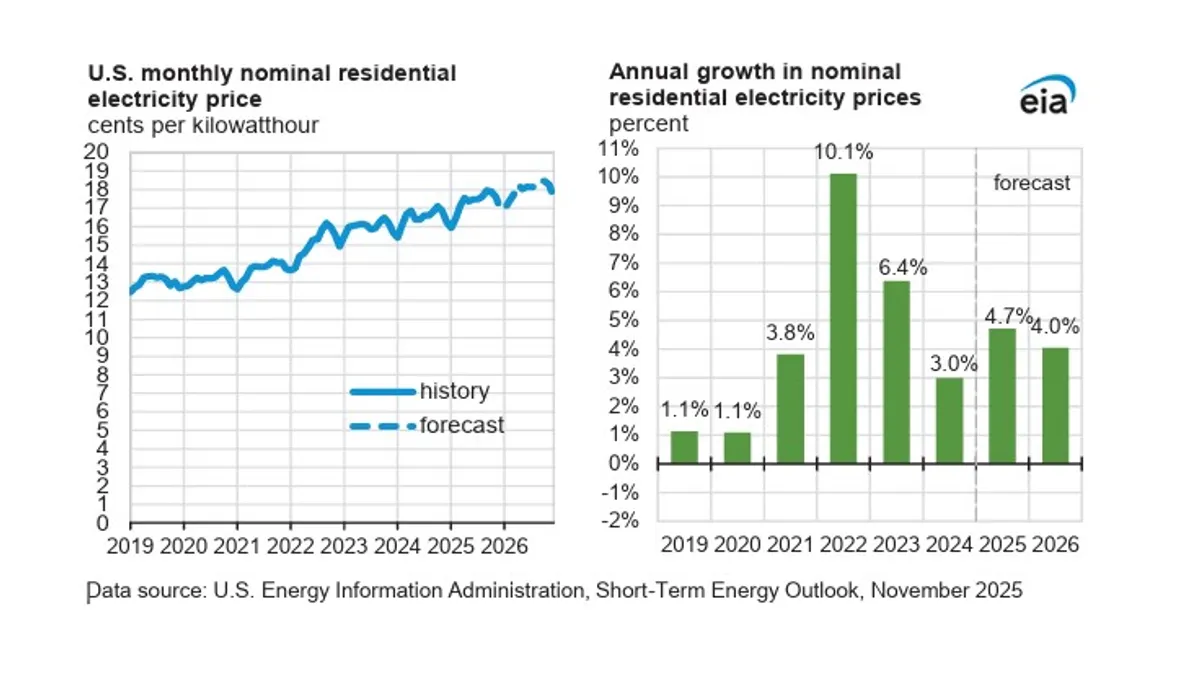The Federal Energy Regulatory Commission on Wednesday held the first day of a two-day technical conference on resource adequacy issues facing grid operators, with most of the discussion focused on the PJM Interconnection’s capacity market.
The meeting was in part sparked by the fallout from PJM’s last capacity auction, which was held in July. Total capacity costs in the auction jumped to $14.7 billion from $2.2 billion in the previous auction. The next auction is set to start on July 9.
Forecast data center load growth, which contributed to tight supply/demand conditions, resulted in a $9.4 billion increase in capacity market revenue in the auction, PJM’s market monitor said in a report released Tuesday. Monitoring Analytics, the market monitor, expects forecast data center demand growth will continue to have a “very significant” effect on capacity market conditions and prices in upcoming auctions.
“Data centers could overwhelm the grids if they chose to,” Joseph Bowring, Market Analytics president, said during the FERC conference.
The solution is to require data center owners to procure new generation for their projects, according to Bowring.
Bowring’s proposal “would put less pressure on the capacity market,” FERC Commissioner Lindsay See said as part of a question to a panel of state utility regulators on whether PJM’s resource adequacy issues are “a data center-driven problem that needs data center-focused solutions.”
Largely driven by data center growth, PJM expects its summer and winter peak load will grow by 3.1% and 3.8% a year on average through 2035, up from 1.6% and 1.9% growth, respectively, in last year’s forecast.
However, it is unclear exactly how much data center load will emerge in PJM, according to panelists. “There's a great deal of uncertainty with this load,” said Emile Thompson, chairman of the Public Service Commission of the District of Columbia and president of the Organization of PJM States Inc., known as OPSI. “I think we can all agree that load forecasts on the large load additions for the next two, three years are probably pretty, fairly solid, but once you get outside of that, we don't know.”
Transparency around data center development in PJM is critical, according to Christine Guhl-Sadovy, president of the New Jersey Board of Public Utilities.
“We are making very significant policy decisions based on the projections … around data center load growth,” Guhl-Sadovy said, pointing to discussions around allowing utilities to build power plants in deregulated states.
Kelsey Bagot, a commissioner with the Virginia State Corporation Commission, called for more clarity on regional data center load forecasts to help policymakers set state policies around issues such as power supply and cost allocation.
Consumer-oriented groups last week urged FERC to lead an effort to improve load forecasts, which they said is critical for resource adequacy and ensuring that electricity prices are as low as possible.
Data centers are “an accelerant to almost every sort of resource adequacy issue that we have, and if you combine that pace with the sort of growing schedule to build and complexity in building fossil generation, or thermal generation, dispatchable … we don't have time to waste,” Adam Keech, PJM vice president of market design and economics, said. “So if we want to keep the resources we have, that's an option. We're still going to need more to meet data center growth. If we lose the resources we have, the hole gets even deeper to dig out of.”
Here are other takeaways from FERC’s technical conference.
First Energy, PPL call for utility role in deregulated states. PPL Electric’s residential customers in Pennsylvania will see about a $15 increase in their monthly electric bills because of the last PJM capacity auction, but without new generation coming online, according to Wendy Stark, PPL’s executive vice president of utilities and chief legal officer.
“There's no reason why we can't have the utilities participate and build generation when it's needed and when ... we're seeing the markets not building new generation,” Stark said, noting that a change in state law would be needed to implement her recommendation.
Given supply chain limits and other issues, it now takes five to seven years to build a power plant, according to Stark. “We need to start taking actions now,” she said.
PJM’s capacity market isn’t working, according to Brian Tierney, FirstEnergy chairman, president and CEO. “Our customers are paying billions of dollars for an advertising campaign that we're calling a price signal that they're not getting incremental new capacity for,” Tierney said. “This is the same capacity market that drove [independent power producers] bankrupt just five years ago because the price wasn't high enough.”
IPPs respond to market signals. Power plant developers and owners have responded to the jump in capacity prices from PJM’s last auction by delaying the retirement of power plants, preparing to bring back mothballed units and proposing new ones, according to Marji Philips, LS Power senior vice president of wholesale market policy.
However, investor confidence in PJM’s capacity market would be improved by regulatory stability, Philips said.
“There's always going to be temptation to tinker in the capacity markets,” Glen Thomas, PJM Power Providers Group president, said. “Do these markets just sort of need time to cook? And I think the answer is yes to that.”
Generally, PJM’s capacity market is working, but it may need some “tweaks,” such as a seasonal framework, according to Thompson.
States want larger role at PJM. Compared to other regional transmission organizations, PJM utility regulators have the least rights in PJM’s decision-making process, according to Thompson. “States should … have more rights and more say in what the capacity construct looks like,” he said.
“Our ability to have a meaningful impact on the resource adequacy planning at PJM has really been stifled,” Guhl-Sadovy said.
OPSI may push PJM “to give us a better say in the decisions that are made from transmission planning all the way to resource adequacy,” according to Dennis Deters, a Public Utilities Commission of Ohio commissioner.
PJM isn’t using available tools to address its pressing resource needs, according to Jacob Finkel, deputy secretary of policy for Pennsylvania Gov. Josh Shapiro, D. “Surplus interconnection, SIS, things like using virtual power plants, VPPs, using the [grid enhancing technologies] that can massively increase the transmission that we already have,” Finkel said. “All the acronyms should be deployed.”























